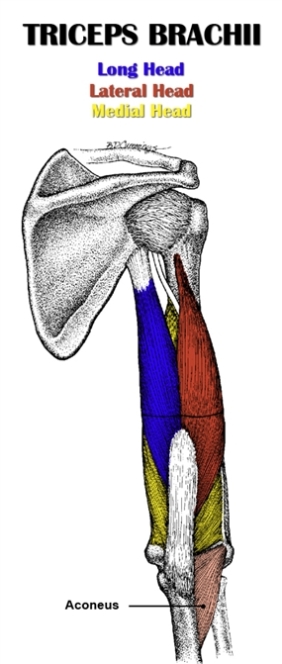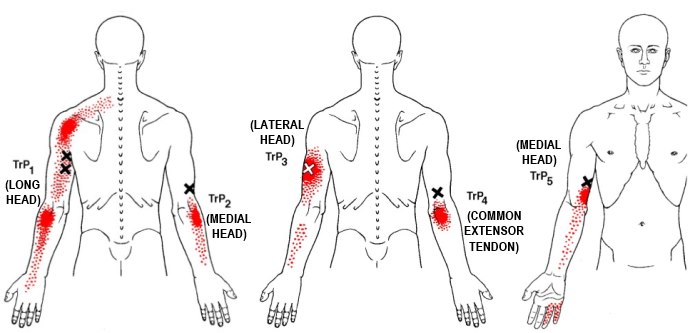Literally meaning the three-headed muscle of the arm, the triceps brachii (L. tres, three ; caput, head ; brachium, arm.) consists of a long, lateral and medial head. It is primarily responsible for elbow extension.

Known commonly as just the triceps, it is twice as big as its counterpart, the biceps brachii, and thus accounts for two-thirds of the upper arm mass.
The triceps brachii makes up the posterior compartment of the arm. It’s located on back of the back of the upper arm, situated inferior to the posterior deltoid and superior to anconeus.
The lateral head of the triceps is positioned on the outside of the back of the arm, while the long head is on the inside. Both lie superficial to the medial head, and their proximal attachments lie deep to the posterior deltoid.
The long head originates just below the shoulder socket on the scapula. The lateral head originates from the proximal posterior humerus, with the medial head arising more distally but having a broader attachment on the lower two-thirds of the arm.
The three heads run inferiorly and converge on the triceps tendon before inserting on the tip of the elbow.
The triceps has a parallel fiber orientation and a fusiform muscle shape.
Also Called
- Triceps
- Tris
- Horseshoe muscle
- Back of the arm
Origin, Insertion, Action & Nerve Supply
| Muscle | Origin | Insertion | Action | Nerve Supply |
|---|---|---|---|---|
| Long Head |
Infraglenoid tubercle | Proximal end of the olecranon of the ulna and fascia of the forearm |
|
Radial nerve (C6-C8)Note: some research (see this and this) suggests the long head is actually innervated by the axillary nerve |
| Lateral Head |
Posterior surface of humerus, superior to the radial groove |
|
||
| Medial Head |
Posterior surface of humerus, inferior to the radial groove |
Exercises:
Note: Only direct triceps exercises are included in the following chart. Movements that train the triceps indirectly include compound chest exercises (e.g. bench press, push up) and compound shoulder exercises (e.g. overhead press, push press).
| Type | Name | Picture |
|---|---|---|
| Barbell: |
 Tutorial: N/A
 Tutorial: N/A
 Tutorial: N/A
 Tutorial: N/A
 Tutorial: N/A
 Tutorial: N/A
 Tutorial: N/A
 Tutorial: N/A
 Tutorial: N/A
|
|
| Dumbbell: |
 Tutorial: N/A
 Tutorial: N/A
 Tutorial: N/A
 Tutorial: N/A
 Tutorial: N/A
 Tutorial: N/A
 Tutorial: N/A
|
|
| Cable: |
|
 Tutorial: N/A
 Tutorial: N/A
 Tutorial: N/A
 Tutorial: N/A
 Tutorial: N/A
 Tutorial: N/A
 Tutorial: N/A
 Tutorial: N/A
 Tutorial: N/A
 Tutorial: N/A
 Tutorial: N/A
 Tutorial: N/A
 Tutorial: N/A
 Tutorial: N/A
 Tutorial: N/A
 Tutorial: N/A
 Tutorial: N/A
 Tutorial: N/A
 Tutorial: N/A
 Tutorial: N/A
|
| Machine: |
 Tutorial: N/A
 Tutorial: N/A
 Tutorial: N/A
 Tutorial: N/A
 Tutorial: N/A
 Tutorial: N/A
 Tutorial: N/A
 Tutorial: N/A
 Tutorial: N/A
 Tutorial: N/A
 Tutorial: N/A
 Tutorial: N/A
|
|
| Weighted: |
 Tutorial: N/A
 Tutorial: N/A
 Tutorial: N/A
|
|
| Bodyweight: |
|
 Tutorial: N/A
 Tutorial: N/A
 Tutorial: N/A
 Tutorial: N/A
 Tutorial: N/A
 Tutorial: N/A
 Tutorial: N/A
 Tutorial: N/A
 Tutorial: N/A
 Tutorial: N/A
 Tutorial: N/A
 Tutorial: N/A
 Tutorial: N/A
|
Stretches & Myofascial Release Techniques:
Stretches
| Name | Picture |
|---|---|
 Tutorial: N/A
 Tutorial: N/A
|
Self Myofascial Release Techniques
When using these techniques, give special attention to the common trigger points shown in the image below.
| Tool | Picture |
|---|---|
 Tutorial: N/A
 Tutorial: N/A
|
Common Issues:
- Inhibited/Lengthened (or otherwise underdeveloped) Triceps Brachii: Compared to the biceps, the triceps tends to be inhibited/excessively lengthened – or it may simply lag somewhat. One potential reason for this is that the biceps are typically activated more in everyday activities, since bending the elbows requires actively resisting gravity in most positions (except when flexing the elbows overhead). Conversely, straightening the elbows is done passively with the help of gravity in most positions (except when extending elbows overhead). Also, more everyday activities or postures involve a bent elbow (e.g. typing on computer, writing, using a smartphone, crossing arms), which entails holding a position where the biceps is shortened and the triceps is lengthened. And let’s not forget that most lifters emphasize biceps training over triceps triceps training. Considering all of the above, it should be obvious why the triceps are often inhibited/lengthened and poorly developed relative to their antagonist, the biceps. Now, with all that said, it’s necessary to add a caveat: this bullet point applies only to the triceps brachii as a whole, but if you consider each head individually, you’ll find that long head is overactive and short in many cases (more on this below).
- Overactive/Short Triceps Brachii Long Head: While the medial and lateral heads of the triceps are prone to becoming inhibited and lengthened, the long head can be overactive and short in many cases. This is most prevalent among those who do a lot of elbow extension with the arm elevated, such as overhead throwing athletes. Even if you’re not an overhead athlete, you may develop tightness in the long head by focusing too much on overhead triceps exercises (e.g. overhead triceps extension, lying triceps extension) and shoulder adduction exercises (e.g. pull ups, lat pulldowns) compared to other triceps movements.
- Triceps Tendinosis: Triceps tendinosis refers to the chronic degeneration of the triceps tendon, resulting in elbow pain especially when extending the elbow. Although inflammation (i.e. tendonitis) may be present when tendinosis first begins to develop, it eventually dissipates. Triceps tendinosis is caused by overuse of the triceps tendon from repetitive or excessively strenuous activities involving elbow extension (e.g. too much pitching/throwing, excessive weight or volume for triceps training). Triceps tendinosis should not be mistaken for the more common conditions of medial or lateral elbow tendinosis, which are caused by overuse of the forearm muscles.
Training Notes:
- If your triceps are excessively lengthened/inhibited, or otherwise weak and underdeveloped, then consider the following advice.
- Increase training volume or frequency on triceps exercises.
- Decrease training volume or frequency on biceps exercises.
- Do biceps release techniques, especially on the short head.
- Try to reduce the amount of time you spend in bent-elbow positions, which contributes to overactivity of the biceps and underactivity of the triceps. Some of the big ones are typing on your computer, playing video games and using your smartphone. You don’t have to completely stop doing these activities; rather you can simply modify your position so that your elbows are straight at least some of the time. That said, it’s a good idea to cut down on (or modify) these activities in general, since they typically involve sitting down and hunching over, which comes with a whole different set of problems.
- If the long head of your triceps brachii is overactive and shortened, consider the advice below.
- Stop doing all overhead triceps exercises (e.g. overhead triceps extension, lying triceps extension), since these exercises emphasize the long head. It’s fine to do non-overhead triceps movements such as the triceps pushdown, close grip bench press and triceps dip – Indeed you should do plenty of this type of triceps training if the medial and lateral heads are weak.
- Try to minimize the involvement of the long head during back exercises involving shoulder extension or shoulder adduction (e.g. rows, pull ups). This may mean you have to work on your form so that you’re activating all the target back muscles sufficiently. However, you may also need to make the triceps long head “calm down” before doing these exercises by releasing the muscle (see next bullet for info on this).
- Perform soft tissue release on the long head of the triceps. Focus on the upper half of the back of the arm, to the inside, as this is where you’ll typically find trigger points.
- Stretchd the long head of the triceps. The type of stretch you choose is irrelevant since the long head is the only head targeted in all triceps stretches. For best results, stretch immediately after soft tissue work.
- If you have triceps tendinosis, do the following.
- See a doctor to rule out other diagnoses and receive an individualized treatment plan. If possible, see an orthopedic doctor or a doctor with a background in sports medicine.
- Avoid activities and exercises that cause pain to flare up. This means you’ll have to stop all triceps and pressing exercises, at least until your pain symptoms begin to clear up.
- If you are at the very beginning stages of the injury where there is inflammation, you may have success with ice therapy (i.e. 20 minutes every few hours) and taking NSAIDs up to 3 times per day. But once inflammation is gone, NSAIDs and icing will only help with pain. You should only take pain medication only as long as it takes for pain symptoms to become bearable.
- Apply heat to the elbow for 15-20 minutes, multiple times per day. This promotes healing by increasing blood flow to the muscles and soft tissues in the elbow region, including the triceps tendon. There are plenty of heat therapy tools
you can use to apply heat to the elbow, such as a heating pad
, balm
or hot water bottle.
- Do 3 sets x 30 seconds of light stretches for both the triceps and the biceps every day. Avoid ranges of motion that cause increased pain.
- Wear a or upper arm band around the lower part of your upper arm. It should be just above the elbow crease so that it’s snug against the triceps tendon. This acts to disperse the stress put on the tendon when triceps is used throughout the day.
- Wear an elbow sleeve during workouts to keep the triceps tendon warm and reduce pain.
- Once pain has subsided to the point where it is tolerable during elbow extension and flexion, you can begin adding in direct triceps exercises and pressing exercises. However, it is important to do very light resistance for high reps. If you experience increased pain, then reduce the weight or volume. Slowly add weight and increase volume over time, using pain as a guide.
- At the same time that you start implementing the regular triceps exercises mentioned in the above bullet point, you should also add in some eccentric triceps exercises, which has been shown to be effective in repairing damaged tendon tissue. As with the regular triceps exercises, the eccentric movements should be done with low weight for high reps, progressively increasing weight and volume over time, as your tendon heals and pain fades.
- You can make any triceps exercise into an eccentric triceps exercise, if you can figure out how to remove or minimize the concentric portion. For example: on the triceps pushdown, have a training partner help push the bar down and then allow you to slowly lower the weight on your own; on the overhead triceps extension, use leg drive/momentum to get the weight overhead, then slowly lower it to the bottom.
- If you just want to build up your triceps and improve the quality of your triceps training, try out the following tips.
- Do (at least) one compound triceps exercise, and have it be the focal point of your triceps training. I personally like the close grip bench press for this purpose, but the triceps dip can also be a good choice for some people.
- The most common mistake on the close grip bench press is going too narrow. All you need is a shoulder width grip. Anything narrower provides no extra benefit to the triceps. In fact, it works the triceps less effectively and puts excessive stress on your wrists and shoulder joints.
- On triceps pushdowns, avoid using momentum or shifting your body position forward in such a way that you’re pressing the bar down (i.e. using chest and shoulders with elbows out) rather than pushing the bar down (i.e. using just your triceps, keeping elbows in).
- Try to avoid flaring your elbows out, in general, on all triceps exercises.
- The more superficial heads of the triceps – the lateral and long heads – are composed predominantly of fast-twitch muscle fibers, which means they respond well to heavier loads and lower reps. Whereas, the deeper part of the triceps – the medial head – is more slow-twitch in its muscle fiber composition; accordingly, it tends to respond better to lighter loads and higher reps.
- Don’t worry about trying to maximally each of the three heads of the triceps unless you’ve been training seriously for at least a couple of years. Just focus on one or two compounds with a couple of your favorite isolation triceps movements mixed in. However, if you are advanced enough where it makes sense to really try to bring up one or more of the heads, individually, then the following is a rough guide on how to do so:
- Long Head: Overhead triceps exercises with heavier weight and lower reps (i.e. 5-12 rep max – going lower than 5 reps on overhead triceps exercises isn’t practical/safe).
- Lateral Head: Non-overhead triceps exercises with heavier weight and lower reps (i.e. 3-12 rep max – only go really heavy on compound exercises like dips or close grip bench).
- Medial Head: Non-overhead triceps exercises with heavier weight and lower reps (i.e. 13-20 reps).
Related Muscles
- Anconeus
- Biceps brachii


